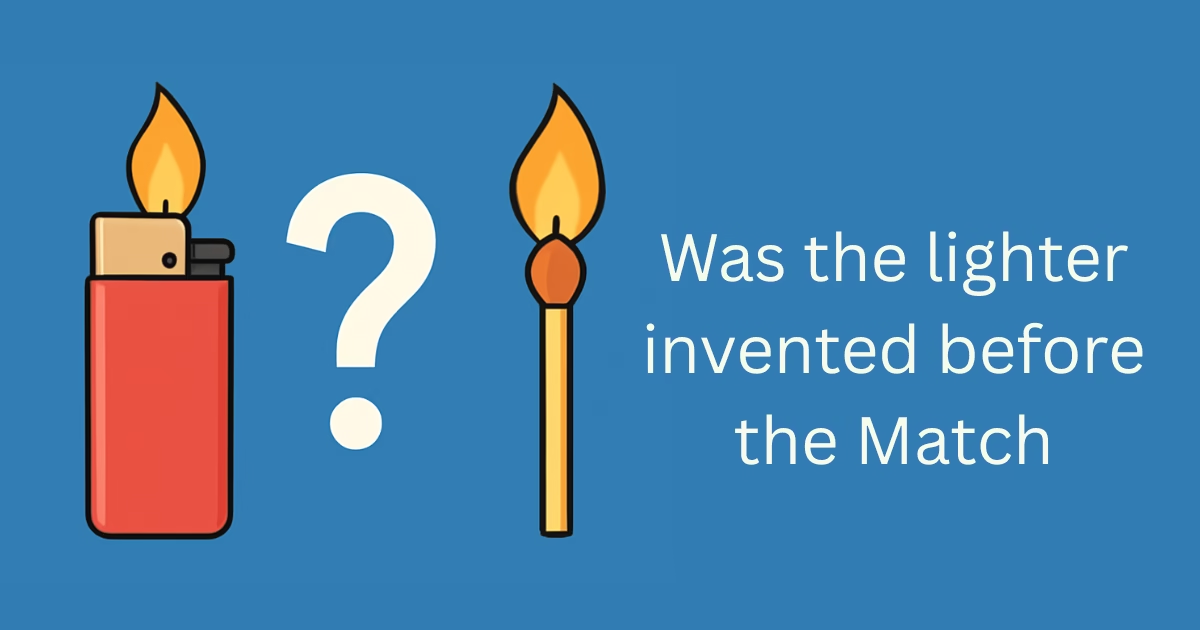When it comes to fire-starting tools, most people would assume that matches were the first invention used to ignite a flame. However, history reveals a surprising fact: the lighter was invented before the match. While modern lighters and matches are commonly used today, their origins are deeply rooted in a fascinating timeline of innovation. In this article, we’ll explore how the lighter came into existence before the friction match, defying popular belief. By examining the history behind these essential fire-starting tools, we’ll uncover the lesser-known stories of the pioneers behind their creation and the technology that led to their development. Understanding this timeline will not only answer the question “Was the lighter invented before the match?” but also shed light on the evolution of fire-starting technology and how it has shaped the tools we use today.
Was the Lighter Invented Before the Match?
When considering the history of fire-starting tools, most people associate the match as the first tool used to create a flame. However, the invention of the lighter predates the modern match by a few years. While both devices serve the same fundamental purpose—starting a fire—the timeline of their invention is often misunderstood.
The first lighter was created in 1823 by Johann Wolfgang Döbereiner, a German chemist. His invention, known as Döbereiner’s Lamp, used a chemical reaction between zinc and sulfuric acid to generate hydrogen gas, which ignited when it came in contact with platinum. Though Döbereiner’s lamp was an essential step in fire-starting technology, it was bulky, expensive, and impractical for everyday use.
Just a few years later, in 1826, John Walker invented the modern friction match, revolutionizing how people started fires. While Döbereiner’s lighter came first, it was the match that became widely used due to its practicality and simplicity. Thus, the history of fire-starting tools reveals that the lighter was invented before the match, though it was the match that ultimately became the most accessible and widely used tool.
The Invention of the Lighter: Döbereiner’s Lamp (1823)
The first lighter in history, known as Döbereiner’s Lamp, was invented in 1823 by Johann Wolfgang Döbereiner, a German chemist renowned for his contributions to early chemistry. Döbereiner’s goal was to create a device that could produce fire without the need for traditional methods like flint and steel. He achieved this through a fascinating chemical reaction.
The lamp worked by combining zinc with sulfuric acid, creating hydrogen gas. This hydrogen gas would then ignite when it came into contact with a piece of platinum, which acted as a catalyst. While this was a groundbreaking development in fire-starting technology, the lamp had significant limitations. The device was bulky, expensive, and required regular maintenance to function properly. Despite its scientific success, Döbereiner’s Lamp was not practical for widespread use, limiting its impact on daily life.
The invention of Döbereiner’s lamp was an important step in the history of fire-starting devices, but it was not until the invention of the match that a more accessible, everyday method for igniting a flame would emerge.
The Invention of the Match: John Walker’s Discovery (1826)
Just three years after Döbereiner’s invention, John Walker, an English chemist, made a breakthrough in fire-starting technology. In 1826, Walker accidentally discovered the modern friction match while stirring a mixture of chemicals.
While working with antimony sulfide and potassium chlorate, Walker noticed that when he scraped a stick across a rough surface, it would ignite. This discovery led to the creation of the first practical match, which could easily be struck to produce a flame. Unlike Döbereiner’s Lamp, Walker’s match was small, portable, and much easier to use.
The friction match was a revolution in fire-starting technology. Unlike the cumbersome and costly lighters of the time, the match was inexpensive, widely available, and incredibly convenient for everyday use. With its ability to quickly and easily ignite a flame, it quickly became the preferred fire-starting tool.
While John Walker’s match was an important advancement, it would take several more years before the match was refined into the safety match that we know today. But in 1826, Walker’s invention marked a significant milestone in making fire-starting accessible to the masses.
Comparing the Lighter and the Match: Which Was More Practical?
While both the lighter and the match served the same basic purpose—starting a fire—their practicality differed greatly. The lighter, though an important scientific invention, was much less convenient compared to the match.
- Ease of Use:
Döbereiner’s lamp was complex and required specific materials like zinc and sulfuric acid, making it difficult to use outside of controlled environments. On the other hand, John Walker’s friction match could be easily struck against any rough surface, making it much more practical for everyday use. - Cost and Accessibility:
Early lighters were expensive and targeted towards scientists and affluent individuals. In contrast, matches were cheap to produce and became widely available. This made them much more accessible to the general population, leading to their widespread adoption. - Portability:
The lighter in its early form was not a portable device. It was a large, bulky object that could not easily be carried around. Matches, however, could be stored in small boxes, carried in pockets, and used on the go.
The friction match quickly gained popularity due to its simplicity, affordability, and ease of use, making it a far more practical solution for daily fire-starting needs than the complicated and costly lighter of the time.
Why the Confusion?
Despite the fact that the lighter was invented before the match, many people mistakenly believe that the match came first. This confusion can be attributed to a few factors:
- Modern Lighters:
Today’s butane lighters are widely used, and their design is far simpler and more portable than the cumbersome early lighters. As a result, people tend to associate modern lighters with the original invention of the lighter. - Widespread Use of Matches:
Matches became the go-to fire-starting tool for most of the 19th and 20th centuries due to their affordability and practicality. This widespread use has led to the false assumption that the match must have been the first fire-starting tool. - Scientific vs. Practical Application:
Döbereiner’s lighter, although groundbreaking from a scientific standpoint, was not as immediately applicable for the average person’s daily needs. The match, being practical and accessible, overshadowed the lighter in terms of real-world use.
By understanding the historical context and the limitations of each invention, we can see how the match, rather than the lighter, became the dominant tool for fire-starting over time.
Modern Lighters and Matches: From the 19th Century to Today
As time passed, both lighters and matches underwent significant improvements. In the 20th century, the development of the modern butane lighter revolutionized the concept of portable fire-starting tools. These lighters are now compact, easy to use, and reliable.
Additionally, the invention of the safety match in 1844 by Gustaf Erik Pasch made matches safer to use, reducing the risk of accidental fires. The safety match could only ignite when struck against a specially prepared surface, preventing unintentional ignition.
Today, we have a variety of fire-starting tools, from butane lighters to electronic lighters, and matches are still widely used in many households and industries. The evolution of both lighters and matches has provided us with options that are more reliable, efficient, and user-friendly than their historical counterparts.
Also Read: 25 Black Friday Fun Facts You Won’t Believe Are True
Conclusion: Surprising Facts about Fire-Starting Tools
The question “Was the lighter invented before the match?” has a surprising answer: yes. While the lighter was invented before the match, it was the match that became the more practical and widely used fire-starting tool.
Döbereiner’s lamp, though groundbreaking, was bulky and expensive, while Walker’s friction match offered a simple, affordable, and portable solution for igniting fires. Over time, the match became the dominant tool, overshadowing the lighter, despite the latter’s earlier invention.
The invention of the safety match and modern lighters in the 20th century has only furthered the evolution of fire-starting tools, providing us with even more reliable and user-friendly options. The history of these inventions reminds us how scientific progress, combined with practicality, leads to the tools that shape our everyday lives.
By exploring the origins of the lighter and the match, we gain a deeper appreciation for these seemingly simple inventions that have had a significant impact on our world.
FAQs: Was the Lighter Invented Before the Match?
1. Was the lighter invented before the match?
Yes, the lighter was invented before the match. The first lighter, Döbereiner’s Lamp, was created in 1823 by Johann Döbereiner, while the modern friction match was invented by John Walker in 1826.
2. Who invented the first lighter?
The first lighter was invented by Johann Wolfgang Döbereiner in 1823. It was known as Döbereiner’s Lamp and worked through a chemical reaction to create fire.
3. Why are matches more popular than lighters?
Matches became more popular than lighters because they were simpler, cheaper, and more accessible. They were also portable and easy to use, unlike the complex and bulky lighters of the time.
4. What is the difference between a match and a lighter?
A match is a small stick that ignites when struck against a rough surface, while a lighter is a device that uses a spark or flame-producing mechanism to ignite a fuel source, typically butane.
5. When were safety matches invented?
Safety matches were invented in 1844 by Gustaf Erik Pasch, who designed a match that could only ignite when struck against a specially prepared surface, reducing accidental fires.
6. How did the match revolutionize fire-starting?
The friction match revolutionized fire-starting by providing a cheap, portable, and easy-to-use method of creating fire, unlike earlier devices that were complex and impractical for everyday use.
7. Are modern lighters based on Döbereiner’s Lamp?
Modern lighters, particularly butane lighters, are not directly based on Döbereiner’s Lamp but evolved from similar concepts. Today’s lighters are much more efficient, compact, and safe compared to the original design.

Hi, I’m Shafy Ali – a curious mind and passionate writer at Celiac Magazine. I cover a little bit of everything, from everyday tips and how-tos to deeper dives into topics that spark conversation. I enjoy turning research into readable, relatable content that informs and inspires. Whatever the subject, I aim to keep it clear, engaging, and genuinely useful.

